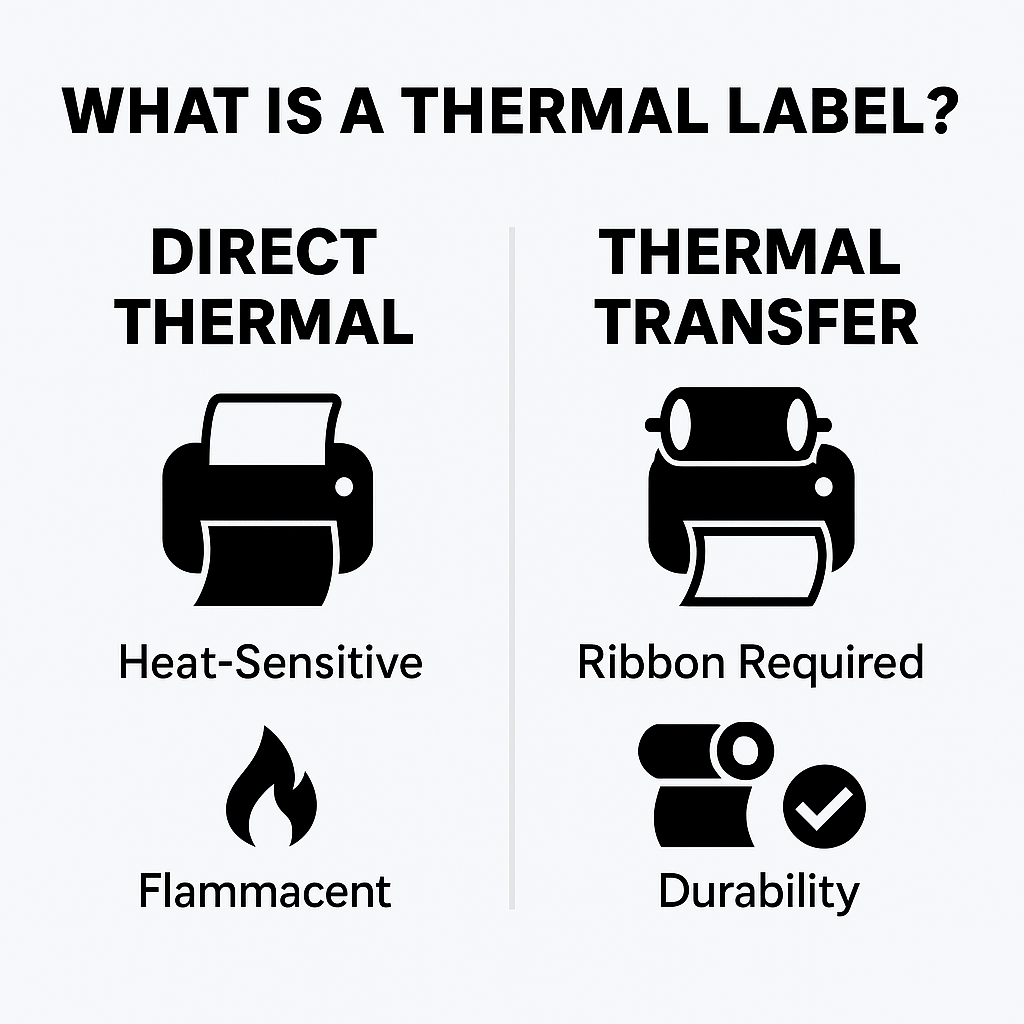A thermal label is a type of adhesive label printed using heat instead of ink. These labels are created by thermal printers, which use either direct heat (for short-term prints) or thermal transfer ribbons (for long-term, durable prints).
Because there’s no ink or toner, thermal labels are cleaner, faster, and more cost-efficient, making them ideal for shipping, inventory, retail, and asset tracking.
🧩 Related reading: Thermal Transfer vs Direct Thermal Labels – Which Type Fits Your Business?
How Thermal Labels Work

-
Direct Thermal Labels use heat-sensitive paper that darkens when exposed to the print head.
-
Thermal Transfer Labels use a ribbon that melts onto the label surface, creating a permanent, high-contrast print.
Both methods are used in GoDEX printers and other thermal systems, depending on the label’s intended lifespan and environment.
🔍 Do Thermal Labels Fade Over Time?
Yes, direct thermal labels can fade if exposed to heat, sunlight, friction, or chemicals. Over time, the paper darkens or loses contrast, especially when used for shipping or warehouse labels.
Thermal transfer labels, however, remain legible for years because the resin or wax ribbon bonds permanently to the label surface.
💡 Pro Tip: Store thermal labels in a cool, dry place away from direct sunlight to extend their lifespan.
🧩 Related post: How to Store and Handle Thermal Labels to Prevent Fading
♻️ Are Thermal Labels Permanent?
That depends on the type of label and the printing method:
-
Direct Thermal Labels: Semi-permanent. Best for short-term use (shipping, retail).
-
Thermal Transfer Labels: Permanent. Designed for long-term use (barcodes, asset tags, lab samples).
If you need waterproof, scratch-resistant, or outdoor labels, go with polyester thermal transfer labels.
🧩 Explore: GoDEX Thermal Transfer Labels – Waterproof & Durable Polyester
🧻 What Are the Types of Thermal Labels?
-
Direct Thermal Paper Labels – low-cost, fast-printing, ideal for temporary use.
-
Thermal Transfer Paper Labels – ribbon-based, more durable for light-duty environments.
-
Thermal Transfer Synthetic Labels – made from polyester or polypropylene, built for harsh or outdoor use.
⚠️ Do Thermal Labels Go Bad or Smudge?
Yes, thermal paper labels can degrade over time, especially in humid or hot environments.
-
The coating reacts to heat, which can cause smudging or blackening.
-
Exposure to oil or UV light accelerates fading.
To avoid smudging, choose resin ribbon thermal transfer labels—they stay crisp and scannable for years.
💧 What Happens if Thermal Paper Gets Wet?
Water is one of thermal paper’s biggest enemies.
When wet, direct thermal labels often blur or lose contrast because their heat-sensitive coating isn’t waterproof.
If your products or packages are exposed to moisture, always use polyester thermal transfer labels — they’re waterproof, chemical-resistant, and tear-proof.
⚙️ What Are the 5 Disadvantages of a Thermal Printer?
-
Fading risk with direct thermal paper over time.
-
Limited color printing — thermal printers are monochrome.
-
Special media required (thermal paper or ribbon labels).
-
Heat sensitivity — high temperatures can damage prints.
-
Higher media cost for durable synthetic labels or ribbons.
Despite these, thermal printers remain the most cost-efficient long-term solution for shipping and industrial labeling.
🧩 Shop GoDEX Label Printers: 203 DPI Printers | 300 DPI Printers | 600 DPI Printers
✅ Conclusion
Thermal labels are the industry standard for fast, reliable printing — from retail and logistics to healthcare and asset tracking.
Choosing between direct thermal and thermal transfer labels depends on how long your labels need to last and what environment they face.
For long-term performance, durability, and crisp readability, GoDEX thermal transfer printers and polyester labels are the best choice.
🛒 Explore Thermal Label Collections:
→ Thermal Labels

